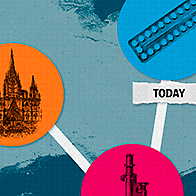Men's Birth Control: Underfunded and Overdue

More than half a century has passed since the invention of oral contraceptive pills ushered in a new era of women's health, rights and family planning. But the freedom that accompanied widely available birth control hasn't been without hardships.
The absence of any male equivalent to "The Pill" means the bulk of contraceptive responsibility in a sexual relationship still falls on women. More often than not, it is women alone who must make the trips to doctors and pharmacies, remember to take a pill every day and endure an array of side effects—including nausea, headaches and mood swings.
Despite endless headlines promising male contraceptives are just over the horizon, no Pill for men has actually arrived. So in our advanced age of medical science, why haven't we cracked male birth control yet?
The squishy issue of male contraception
In a phone interview, Logan Nickels, Ph.D., of the Male Contraceptive Initiative (MCI), called the problem of male birth control "squishy." Compared to the rigid nature of his former work in microbiology, his job as research director of the MCI has been a pliable mishmash of advocacy, fundraising and research.
That's because the issue his organization is working to solve—the absence of safe and effective male birth control—isn't just scientific, but social and economic as well. Each of these elements intermingles into a "big murky bubble," he said.
"[With] contraception there's so much more that goes into it," Nickels said. "There's the very obvious pieces of gender equity, but then there's the more nuanced ideas of reproductive autonomy and granting people things many would consider human rights."
The economics of male birth control
Funding male contraceptive research has long been a persistent problem, he explained. Large pharmaceutical companies aren't convinced a Pill for men is worth the upfront investment, so development often falls on smaller bodies with fewer resources.
A big part of Nickels' job is generating funding for these small research efforts. The MCI also works to convince entities with deeper pockets that there's a significant potential market for male contraceptives. And the demand is there, Nickels claimed.
"We're not creating demand for male contraception that doesn't exist," he said. "Men want to be responsible, men want to help their partners."
The male reproductive being
Given the liberatory impact of The Pill, it makes sense female reproductive autonomy was "priority one," Nickels conceded. However, part of the reason no male equivalent has followed is due to the way scientists—and our broader society—think about men's bodies.
Nickels explained that throughout the history of medicine, male bodies have been considered the default, with one exception—reproductive health.
"We don't see men as reproductive beings, for the most part," Nickels said. "It's very interesting how we've made this androcentric—this man-centric—universe, but that we've said, 'Oh no, this one part you're not in.'"
The scarce research on male reproduction presents a significant obstacle to contraceptive research, he told me. He offered the example of sperm count and fertility, a critical piece in the development of male contraceptives.
"Hormonal contraception for men works by lowering sperm count below a threshold below what is considered fertile," Nickels said. "We only knew what that threshold was like 20, maybe 30 years ago."
The science of male hormonal birth control
For all the economic and social barriers, the science of developing a male counterpart to female hormonal contraceptives presents a unique challenge, too.
Diana Blithe, Ph.D., program chief of the Contraceptive Development Program, explained the difference isn't the contraceptive hormones themselves, but the female and male anatomy they interact with.
According to the National Infertility Association, healthy male bodies can produce between 40 to 300 hundred million sperm cells per milliliter of ejaculate—in contrast to the single female egg required for conception. Impregnation can still occur when sperm counts are fewer than 3 million per mL, Blithe said.
Nickels explained that throughout the history of medicine, male bodies have been considered the default, with one exception—reproductive health.
The current drugs in development use progestin—the same hormone used in The Pill—to shut down testosterone in the testes and reduce sperm production. Sperm counts must be below a threshold of about 1 million sperm cells per mL to prevent conception. But this mechanism creates another problem.
"It also lowers testosterone in the blood, which will shut down sexual function and things you don't want to shut down," Blithe said.
To counteract the loss of testosterone, any contraceptive treatment has to add it back somehow. But current testosterone replacement therapies—such as the topical, nasal and intravenous methods used to treat hypogonadism—typically required several doses per day, Blithe said.
So part of the challenge has been developing a contraceptive that doesn't require multiple daily trips to the bathroom to slather on large qualities of gel or stick yourself with a needle.
Human trials of male contraceptives are underway
Several easy-to-use male birth control treatments are already showing promise in clinical trials. Two once-a-day pills, 11-beta-MNTDC and DMAU, have already passed through early human testing.
Blithe herself is overseeing the development of a topical gel called NES/T, which she said would only require applying half a teaspoon to each shoulder every day. Development began in 2005 and is now in phase 2—conducting a "very large" study of couples who use the gel as their sole means of contraception.
A handful of non-hormonal treatments are also being explored. Nickels, whose organization focuses solely on non-hormonal treatments, pointed to a vas-occlusive hydrogel called ADAM that will soon be entering human trials.
Side effects?
In 2016, researchers shut down a promising clinical trial, citing participants' reports of negative symptoms, including depression, acne, mood swings and changes in libido. A media narrative quickly emerged that men couldn't hack the side effects of hormonal birth control—the same effects women have endured for decades.
Several outlets covered the study's failure as a result of guys simply being weenies. A USA Today headline put it plainly: "Male birth control study nixed after men can't handle side effects women face daily."
But Blithe said the general eye-rolling that followed the study's cessation left out key information.
First and foremost, most of the participants themselves seemed to tolerate the side effects just fine—85 percent expressed they found the treatment and the side effects acceptable. Only 20 of the participants discontinued due to "adverse events," according to the study.
But the independent Data and Safety Monitoring Committee (DMSC) advised researchers to halt the study, citing serious side effects experienced by a small number of participants.
"It wasn't stopped because there were mild mood effects," Blithe said. "It was stopped because there were some serious mood effects—there was one suicide and there was one suicide attempt and there was one very serious depression."
The suicide was ruled unrelated to the clinical trial, according to the text of the study. But the DSMC ultimately decided "the risks to the study participants outweighed the potential benefits to the study participants."
Most of the articles pointing to this study as evidence that male fragility stands in the way of male birth control have somewhat missed the mark, Blithe argued.
"I think they were being a little too hard on the male participants," she said.
Risk, benefits and regulations
A double standard does exist between the sexes when calculating the risk vs. benefit for contraceptives. Not all of it can be attributed to sexism (though historically, much of it can).
There is also a practical regulatory explanation for this double-standard, Blithe explained. Female contraceptives weigh their adverse effects against the risk of pregnancy—which carries its own potential health complications. Male contraceptives do not.
"The rationale with women is you're willing to accept a certain amount of risk, because the risk from pregnancy is greater," Blithe said. "In this case, the man is willing to accept a certain amount of risk, but he's not preventing something in himself, he's preventing it in his partner—which is a little bit of a different risk/benefit calculation."
Blithe speculated these disparities in the risk/benefit calculations might impact the threshold for side effects that regulatory boards like the FDA consider acceptable.
Luckily, Blithe hasn't seen too much in the way of concerning side effects so far in her own study (though it's too soon to say for sure). On the contrary, she said most of the couples express a great deal of interest in continuing the treatment.
"We're not seeing a lot of side effects, [though] I think it's too early to tell you what we are seeing," Blithe said. "But most of the couples who have finished have been really positive and wish they could continue to use it."
Okay, but how long until we get a male 'Pill'?
Blithe said many people are dismayed to learn the realistic timeline for male contraceptives passing through clinical trials, receiving regulatory approval and reaching your local pharmacy shelves.
"I can tell you with certainty that there will not be a product within five years, even if this [contraceptive gel] works perfectly," Blithe said. "I get people very depressed when I give this talk—I get them really excited when it's all results, it's all really wonderful—but then I say it's gonna be 10 years before you see a product, they all get crestfallen."
Blithe and Nickels agreed nonhormonal contraceptives may receive approval sooner, depending on their success in human trials—though none have quite entered this stage at time of writing.
'The man is willing to accept a certain amount of risk, but he's not preventing something in himself, he's preventing it in his partner—which is a little bit of a different risk/benefit calculation.'
There's a common joke about male birth control that "we've been 10 years away for 50 years," Nickels said. Past treatments have generated lots of enthusiasm only to end up in something called the "Valley of Death"—a phase between the early discovery stage and before human trials, past which many promising treatments never progress.
Despite past hurdles, Nickels is optimistic male birth control is closer than it's previously been. Many promising treatments have made it past the Valley of Death, and public interest is at an all-time high.
"There are more people in this field than there's ever been, there's more money moving things forward, and there's more interest from the public—which I think is one of the really key bits," Nickels noted.
Blithe agreed public enthusiasm is key to the future of male birth control, and urged those interested in a pill for men to ramp up their advocacy.
"I really think if people are patient and if we have advocacy from the men who make it clear that they want this, eventually it will happen," she predicted.



















